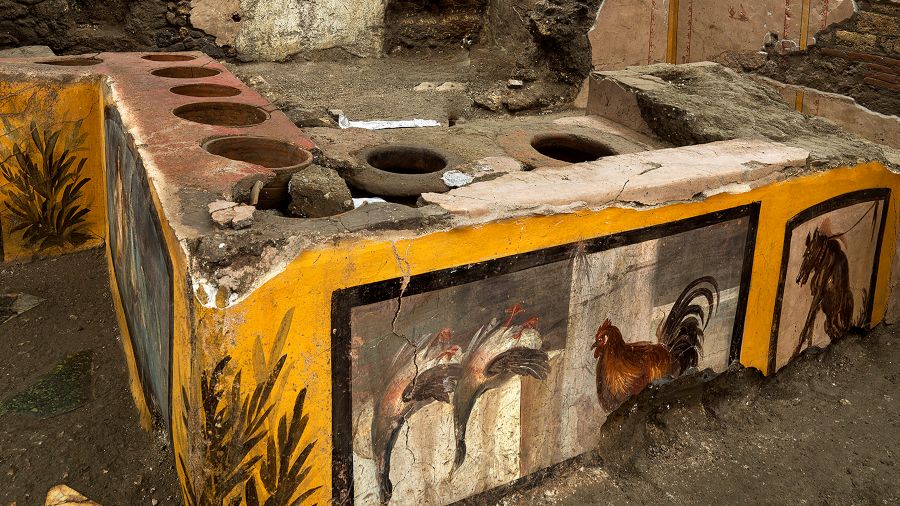
The scientists found food scraps in the recesses of the table that could provide valuable information about the gastronomic customs of the place.
The archaeological area of Pompeii, the city that was destroyed in 79 AD. The eruption of Vesuvius continues to amaze and this Saturday the discovery of a thermopoly (thermopolium), a kind of ‘fast food’ in the middle of the street in ancient Rome, where food and drink was served to the inhabitants, which It is intact and decorated and with food remains.
The Italian Ministry of Culture and the Archaeological Area announced what they considered “another extraordinary discovery in Pompeii, in the new excavations undertaken as part of the Region V maintenance and restoration project”.
The counter kept by the volcanic ash was partially excavated in 2019, but the works were expanded to try to preserve the whole archaeological site as best as possible, and it is located in a very busy area, at the crossroads of the streets of Plata and Los Balcones weddings.
It is a thermopoly, where food was served to the lower classes of the city, perfectly preserved with the counter top depicting a horse nymph and other animals with colors so bright as to appear three-dimensional, they explain, including Poultry, such as chickens and mallards, which had to be washed down with wine or hot drinks, stand out.
MAYBE INTERESTED: 5 scientific discoveries that have gone unnoticed since the coronavirus emerged
But what has surprised archaeologists the most is the discovery in the containers of the remains of this food sold on the street, which is the origin of “takeaway” food.

The counter buried by volcanic ash was partially excavated in 2019, but work was expanded to better preserve the entire site. Photo / AFP
Scientists found food scraps in the recesses of the table that could provide valuable information about gastronomic practices in Pompeii at the time of the eruption of Mount Vesuvius in AD 79.
A fragment of duck bone was found in its place, along with remains of pigs, goats, fish and snails in clay containers. Multiple ingredients were cooked together as if it were a paella.
Crushed beans were found at the bottom of a container, which were used to change the flavor of the wine.
MAYBE INTERESTED: A New Face of Joya de Cerén, the Pompeii of America
“In addition to being a testimony to everyday life in Pompeii, the possibilities to analyze this thermopoly are exceptional, as a complete set has been excavated for the first time,” said Massimo Osanna, General Director of the Archaeological Park of Pompeii, delighted . it is a statement.
Amphorae, a cistern, and a fountain were found near the site, as well as human bones, including those of a man in his 50s, near a cot.
“The thermopoly gives the impression of having been hastily closed and abandoned by the owners, although it is possible that someone, perhaps the older man, stayed and died during the first phase of the eruption, when the loft collapsed,” Osanna said. in an interview with the local agency Ansa.
The other skeleton could be that of a thief or a hungry fugitive, “surprised by the burning fumes that spread in one hand the lid of the container he had just opened,” he added.
The “Thermopolia” (the compound word comes from the Greek “thermopōlion,” meaning hot food to sell) was very common in the Roman world. Only in Pompeii there were about 80.
Completely covered by the eruption of Mount Vesuvius in AD 79, the city is the second most visited place in Italy after the Roman Colosseum, with nearly four million visits in 2019.
So far, only a third of the site, which currently covers about 44 hectares, not far from Naples, has been excavated by archaeologists.
MAYBE INTERESTED: “Unique” Find: Two Thousand Year Old Underground Complex Discovered in Jerusalem